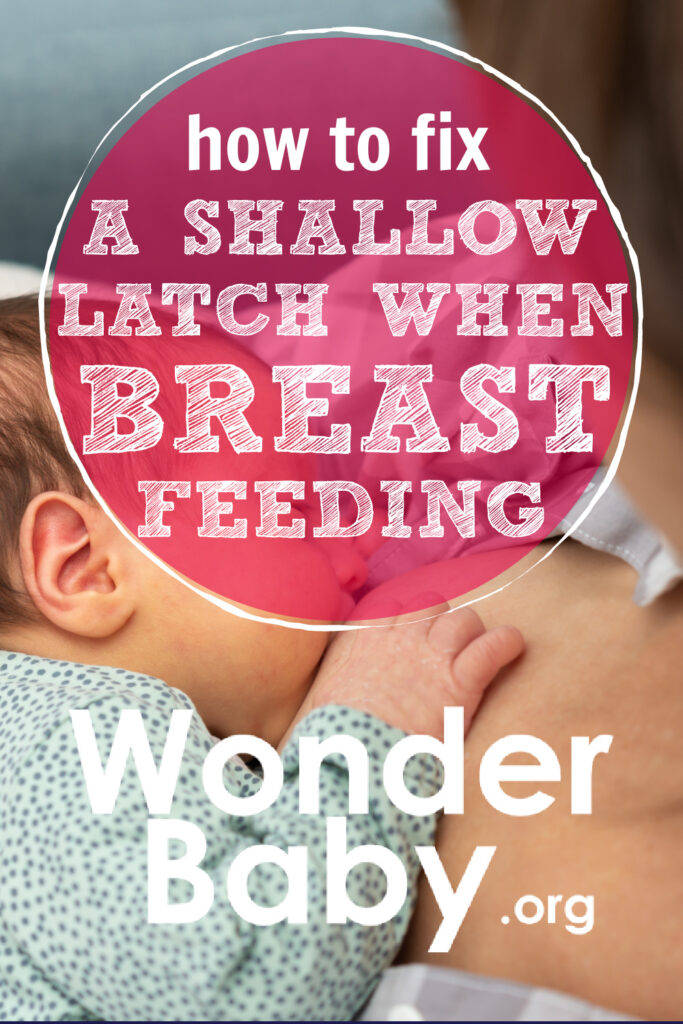How to Fix a Shallow Latch When Breastfeeding

- A shallow latch is when a breastfeeding baby’s mouth latches onto the mother’s nipple but they don’t get enough of the breast in their mouth.
- In a deep latch, there should be no pain present and the entire areola, or a good majority of it, should be in the baby’s mouth.
- Improper breastfeeding positions can cause a shallow latch.
I remember the first time I breastfed my baby. I came home from the hospital with high hopes and a plan to master breastfeeding. I figured if so many women did it, it couldn’t be that hard.
But I had no idea what I was in for. It turns out that breastfeeding can be a challenging journey. I found myself up at night, researching mastitis vs thrush, how to cure a clogged milk duct, and a host of other issues I encountered while nursing in those early weeks.
One of the most painful parts of breastfeeding was correcting a bad latch. My first baby had a poor latch which caused a lot of nipple pain. Her shallow latch caused blisters and had me scouring the aisles of Target for nipple cream for breastfeeding.
If you have intense pain while breastfeeding, you could be experiencing a shallow latch. A shallow latch can cause a lot of stress for both mom and baby. However, with the right advice and some practice, you’ll be able to correct your baby’s shallow latch and confidently master breastfeeding.
If you’re wondering what a shallow latch is and how to fix it, you’re in the right place. We’ll help you determine if a shallow latch might be causing your breastfeeding pain. We’ll also give you the best breastfeeding tips to fix a shallow latch.

What Is a Shallow Latch?
A shallow latch is when a breastfeeding baby’s mouth latches onto the mother’s nipple but they don’t get enough of the breast in their mouth. When this happens, the mother will experience a pinching sensation and breastfeeding will be difficult and uncomfortable.
Shallow Latch vs Deep Latch
Ideally, your baby should have a deep latch on your nipple when breastfeeding. With a proper latch, you shouldn’t feel any pain while nursing. There are several signs to look for to determine if your baby has a shallow or deep latch.
How do you know if your baby has a shallow latch?
We know that a shallow latch means that your baby isn’t latching on to enough of your breast. But maybe you’re unsure of what a deep latch looks like.
Here’s an easy test you can do at home. Place your baby on your breast to nurse and look for the following signs:
- You have pain in your nipples.
- Your baby’s lips aren’t turned out around your nipple.
- Your baby’s cheeks aren’t full and round while nursing.
- Your baby is making clicking noises while sucking.
- Your baby has milk dribbling out the sides of their mouth.
- Your baby is sucking on only the nipple and doesn’t have the majority of the areola in their mouth.
With a shallow latch, these symptoms may also be present after a nursing session:
- Your baby is extra fussy and gassy.
- You have cracked, sore, blistered, or bleeding nipples.
- Your milk supply isn’t increasing after several weeks of nursing. (If there are no other symptoms present with your low milk supply, you might try other ways to increase your milk like power pumping.)
- Your nipple looks flattened or slanted after nursing. (Could also be a sign of lipstick nipple latch.)
What does a good latch feel like?
A good latch should feel comfortable for the mother. There should be no pain present and the entire areola, or a good majority of it, should be in the baby’s mouth. Your baby’s lower and upper lip should be turned out around the nipple and their cheeks should look full.
You’ll also notice that your baby’s chest and head are positioned toward you, with your baby’s head straight. The baby’s chin should rest against your breast. You’ll also be able to hear and see your baby swallow the milk.

What Are the Causes of a Shallow Latch?
There are two common causes of a shallow latch in a breastfeeding baby:
Improper Breastfeeding Position
A shallow latch is often caused by improper breastfeeding positions. When the baby is positioned incorrectly at the breast, the baby’s mouth is unable to get a deeper latch. Your baby’s ears, shoulders, and hips should all line up so that your baby can swallow correctly.
You might be tempted to lean forward and bring your breast to your baby. However, for a proper latch, you’ll want to securely hold your baby and bring their mouth to your breast instead.
Tongue or Lip Tie
Another common cause of an improper latch is upper lip ties or tongue ties. This is where the tongue or upper lip is improperly connected to the mouth. This will limit the movement of both the lips and the tongue.
To see if your baby has a tongue or lip tie, you should have them evaluated by a pediatrician or pediatric dentist.
Why do babies push away when latching?
If your baby pushes away while latching or feeding, this can be a sign of a forceful letdown. If your milk comes out too fast, your baby will pull away and might cough. This is their body’s natural reaction to protect themselves from choking.
Can You Breastfeed Successfully With a Shallow Latch?
Starting breastfeeding with a shallow latch is unlikely to lead to a successful breastfeeding journey. Many babies with a shallow breastfeeding latch don’t gain enough weight. Without a good latch, babies can’t suck enough milk from the breast.
Also, mothers of babies with an improper breastfeeding latch will likely experience a lot of pain. They might also be discouraged if they see signs their milk is drying up or signs of a low milk supply. These factors alone make long-term success unlikely.
The emotional and physical toll breastfeeding takes on a mom can make her quit long before she intended. This is why it’s important to correct a shallow latch early on.
Why is a proper latch important?
Learning the deep latch technique will not only prevent pain but will signal your body to make more milk. Here are a few ways that a proper breastfeeding latch benefits mom and baby:
- Helps prevent mastitis or clogged milk ducts
- Prevents cracked, blistered, or bleeding nipples
- Allows the baby to suck properly and get more milk from the breast
- Signals the body to produce more milk when the breast is emptied

Tips and Tricks to Help Your Baby Latch Properly
If you notice your baby’s latch only covers the nipple, causing intense pain when nursing, your baby might need a little help latching deeply. Thankfully, proper latching can often be achieved with these breastfeeding tips and tricks.
Relax.
Before you start your next nursing session, take a minute to do some deep breathing, praying, or breathing in some calming essential oils. If you are stressed, it will be difficult to help your baby get a comfortable latch without getting frustrated or discouraged.
Also, be sure not to wait too long to feed your baby. If you wait to feed your baby until they are frantic, your stress levels will rise. Try offering your breast before your baby signals they are hungry.
Try a different breastfeeding position.
Many breastfeeding positions will put your baby in the optimal position for breastfeeding. These include a cradle hold, cross cradle, and football hold.
However, certain positions are better for supporting your baby’s natural rooting reflex and their ability to self-latch in the early days of breastfeeding. We recommend trying the laid-back breastfeeding position and the side-lying position first.
Laid-back position:
For this position, recline back with your head and shoulders supported. Both breasts should be exposed and your baby should be dressed in only a diaper for maximum skin-to-skin contact. Place a blanket over your baby if the room is cold.
Lay your baby, chest down on your stomach and chest. Allow your baby to root and find your breast while you support their head and neck. Be sure your baby opens their mouth wide before latching onto your breast.
Side-lying position:
For a side-lying position, lie down with your baby on the bed. You should turn your baby on their side, with your baby’s stomach facing you. Pull your baby in close and cradle their back with your arm.
Your baby’s mouth should be level with your nipple. As they root for your nipple, ensure their mouth is wide open before they latch.
Be sure that your bed is free of all loose blankets before trying this position to keep your baby’s nose free of obstructions and prevent suffocation.
Support your breast.
As your baby approaches your breast, you might need to hold it in a U-position so they can latch deeply. To do this, place your thumb behind the top of your areola and your forefingers behind the bottom of your areola, creating a U-shape. Lightly squeeze your breast tissue as if you were squeezing the layers of a sandwich before a bite.
Wait for an open mouth.
In order for your baby to get a deep latch, their mouth will need to be wide open. Try offering your breast to your baby by touching their top lip with your nipple. With their mouth wide, guide them to your nipple, while also supporting your breast.
If your baby’s upper and lower lip aren’t turned out, and you’re still experiencing pain, try again. To release the latch, gently insert your finger in the corner of your baby’s mouth until you feel the suction release.
FAQs
When should you hire a lactation consultant for a shallow latch?
If feeding remains troublesome after trying the above tips, you might want to consider hiring a lactation consultant to help. Lactation consultants are able to identify the telltale signs of many breastfeeding issues. They will also be able to give you the emotional support and encouragement you need.
Do babies latch better as they get older?
Yes. This is great news for moms breastfeeding newborns. When you start feeding your newborn, they will likely need your support and help with latching.
However, as they get older, they become professional breast-feeders. You’ll be able to simply offer your breast, and your baby will take over from there. Getting through the earliest days of breastfeeding is the most crucial period.

The information WonderBaby provides is not intended to be, and does not constitute, medical or other health advice or diagnosis and should not be used as such. Always consult with a qualified medical professional about your specific circumstances.
Related Posts

Breastfeeding, Sleep
Sleep and Breastfeeding: A Comprehensive Guide for Nursing Moms
Many people assume breastfeeding and sleep training don’t go together, but it is possible to help your baby sleep better while continuing your breastfeeding journey.

Breastfeeding
Comfort Nursing: Pros, Cons, and How to Stop
Find out what comfort nursing is, when should you worry about it, and how to stop or limit your baby's comfort nursing (especially at night!).

Breastfeeding, Product Reviews
5 Best Breastfeeding Chairs for Nursing Moms of 2023
Whether you want a gentle rock, a smooth glide, or a cozy cuddle to soothe your baby to sleep, you’ll have your pick of the best breastfeeding chairs on the...